Katherine Langrish's Blog, page 31
December 14, 2012
Rich and Poor
The Rich and the Poor
A tale of Peig Mhóron from the Great Blasket
Taken from ‘The Western Island’ by Robin Flower, Clarendon Press 1944
I said, “Some say… if all the money in the world were divided up among all the people, all could live easily and there would be neither rich nor poor.”
“Don’t believe them, Bláheen; for that plan was tried once, and we all know what came of it.
It was this way. There was a good king once. The people liked him well, but they liked the queen, his wife, even better. For all she wished at all times was to keep the poor people up. And she was always complaining, asking why it was that the poor people didn’t get fair play to lift them out of their poverty. One day she spoke to the king, “I hope, O king,” she said, “that you will do something for me and give the poor people fair play.” “Very well, my queen,” said he, “you shall have your desire.” She was very pleased then but perhaps she wasn’t so pleased afterwards. The king made proclamation that certain things should be done, that everyone should be put in a good way and be able to manage for himself.
It wasn’t long till the poor people were getting in a good way, and in a few years they wouldn’t be at the trouble to buy or sell anything. And one day it came to pass that there wasn’t a potato to be bought in the market. When it was dinner time, and they sat to table, the queen saw no potatoes coming. “What’s this?” she said. “Isn’t there a potato for my dinner today?” “Well if you haven’t got a potato,” said the king, “you have your will. You wouldn’t be satisfied till the poor got fair play, and now, when they have their own way, they don’t trouble to do anything for you and me. You ought to be satisfied.” “O if that’s the way of it,” said the queen, “You’ll have to put a stop to this work. I must have potatoes for my dinner.” So the king had to rein in the poor again, and bring them under subjection. And then the queen was satisfied.”
Peig rose from her stool on the floor and, “Well Bláheen,” she said, “We’ve been a long time talking, and people will be saying of me that I do nothing but sit and tell tales, and it’s time you were going home to your dinner.
“It is,” I answered, and we went to the door and looked out. The sun was going down into the western sea, and its rays struck across on to the mainland. Away up on the side of Sliabh an Iolair, above Dunquin, a cataract could be seen flashing white in the light of the evening sun.

“Do you see that fall?” she said. “It was in a house below that fall I lived when I was a girl, till it was time for me to go into service. And I was married at seventeen. You wouldn’t see anywhere a merrier girl than I was till that time, for it is youth that has the light foot and the happy heart. But since the time I was married I have never known a day that I was entirely happy. My husband was a sick man most of his days, and then he died and left me, and I brought up my children to read and write, and there never were children with cleverer heads for their books; but there was no place for them in Ireland, and they have all gone to America but one, and soon he too will be gone, and I shall be alone in the end of my life. But it is God’s will and the way of the world, and we must not complain.” And she threw her shawl over her head and turned back into the darkening house.
Picture credit: Sliabh an Iolair (Mount Eagle) from the Great Blasket Island, by
Published on December 14, 2012 05:44
December 7, 2012
Anyone for Stew?
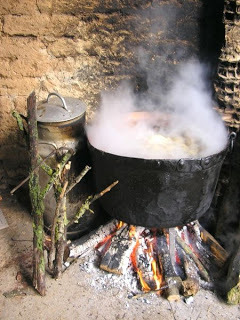 In 'The Tough Guide to Fantasyland', Diana Wynne Jones warns travellers through that magical land that the only thing they'll ever be offered to eat on their Quest - whether in a Tavern, Alehouse, or Camp - is stew. Unless of course they are being entertained by an Enchantress who intends to seduce them, in which case "jellies soother than the creamy curd,/And lucent syrops, tinct with cinnamon" will be the least of it.
In 'The Tough Guide to Fantasyland', Diana Wynne Jones warns travellers through that magical land that the only thing they'll ever be offered to eat on their Quest - whether in a Tavern, Alehouse, or Camp - is stew. Unless of course they are being entertained by an Enchantress who intends to seduce them, in which case "jellies soother than the creamy curd,/And lucent syrops, tinct with cinnamon" will be the least of it.Stew. She's right, of course. During the effort of creating a coherent fantasy world, authors sometimes just get tired. All the stuff we have to provide for our characters to carry around with them, in order to make it over the mountains, through the forest, and across the desert! Backpacks, ponies, sacks of flour! Do we have to do the cooking for them, too? And so it's easier to picture a cooking pot slung over the flames, with some indeterminate mess bubbling away inside - and throw in a couple of references to snaring rabbits, digging for roots, and hunting. "What the heck, after all," we think, "can you cook in the open air, over an open fire, except stew? Or possibly porridge?"
There's a scene in the movie of the Fellowship of the Ring where Aragorn returns to camp with a dead deer slung over his shoulders. Interesting. Except they'd be moving on next day. You try cutting up a dead deer and sticking it into a cooking pot small enough to hang over a campfire. Or else carting raw meat around with you on a hike. No wonder Tolkien's elves invented lembas - light, portable, nutritious and apparently vegetarian - the culinary equivalent of that useful phosphorescent stuff that appears on the end of wizards' wands (or simply clings to the walls) to light up otherwise lightless caves.
I must hold my hand up here, I think I've occasionally given my own characters stew (and mysterious glowing lights), but I try nowadays to come up with other ideas. In 'Dark Angels', set in the late 12th century, it was fun to reference real medieval dishes, such as blancmange - minced chicken with pounded almonds - for the meals at the high table of La Motte Rouge, Lord Hugo's motte and bailey castle. One character in the book is a highly food-centered house-hob:
The hob yawned, showing a lot of yellow teeth. "What's for supper tonight? Roast pork and crackling?"
"It's Friday," said Nest, wiping her eyes.
"Is it?" The hob's face fell. "No meat," it grumbled. "Fasting on Friday. Who thought that one up? What's the point?"
Nest sat up. "Fasting brings us closer to the angels," she said coldly. "Angels never eat. they spend all their time praising God."
"Only cos they ain't got stummicks," the hob muttered. "Go on then, what's for supper? Herbert's not the worst cook I've ever known. We won't starve. Fish, I s'pose? A nice bit of carp, or trout?"
And in the end, the meal turns out to consist of fish in batter with a sharp sauce, followed by a sweet omelette.
Of course it's easier if you're writing the sort of fantasy which isn't affected - indeed, may even be enhanced - by the mention of anachronistic or otherwise out-of-place types of food. In Hobbiton, the affectionately 'English' area of Middle Earth, no reader is going to mind references to potatoes, fish and chips, buttered toast, birthday cake, et cetera. In 'The Hobbit', Gandalf and the dwarves demand all kinds of food from poor Bilbo, all of it either English, or, like coffee, at least readily available in England:
"Tea? [said Gandalf] No thankyou! A little red wine, I think for me."
"And for me," said Thorin.
"And raspberry jam and apple tart," said Bifur.
"And mince pies and cheese," said Bofur.
"And pork-pie and salad," said Bombur.
"And more cakes - and ale - and coffee, if you don't mind," called the other dwarves through the door.
... "Put on a few eggs, there's a good fellow," Gandalf called... "And just bring out the cold chicken and pickles!"
Much of 'The Hobbit' has a lighter, more frivolous tone than 'The Lord of the Rings' ( and I disliked it as a child; I preferred serious fantasy) - so this stodgy 20th century English menu works well as comedy. But it's impossible, I think, to imagine coffee or tea being offered to guests anywhere in Minas Tirith or Edoras. Even Sam's throwaway remark about fish and chips, to Gollum in Ithilien (in the chapter entitled 'Of Herbs and Stewed Rabbit'), has always made me feel uneasy. Chips? Where have the potatoes come from? Middle Earth is so clearly Early European in its culture/s, that I just feel there shouldn't be potatoes. I can cope with pipe-weed, because Tolkien has (thinly) disguised it. It might not be nicotiana. People smoke all kinds of things. But potatoes? What is Middle Earth's geographical relationship to the Americas?
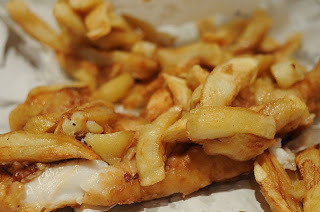
I'm more comfortable with the frivolous tone in Kenneth Grahame's 'The Wind in the Willows'. Here, for example, the Water Rat (a charming Oxbridge type of fellow) packs this magnificent picnic into a 'fat wicker luncheon basket':
"What's inside it?" asked the Mole, wriggling with curiosity."There's cold chicken inside it," replied the Rat briefly, "coldtonguecoldhamcoldbeefpickledgherkinssaladfrenchrollscresssandwichespottedmeatgingerbeerlemonadesodawater -""Oh stop, stop," cried the Mole in ecstasies: "This is too much!""Do you really think so?" inquired the Rat seriously. "It's only what I always take on these little excursions, and the other animals are always telling me that I'm a mean beast, and cut it very fine."Kenneth Grahame's animals are so anthropomorphised that even their size is indeterminate - the Toad can drive a car and pass himself off in human society as a washerwoman - so it's perfectly all right for them to eat human food too. Even bubble and squeak - a peculiarly English concoction of fried potato and cabbage - makes its appearance in “The Wind In The Willows”. And the jailer’s daughter, pitying the poor imprisoned Toad, brings him:
“…a tray, with a cup of hot tea steaming on it; and a plate piled up with very hot buttered toast, cut thick, very brown on both sides, with the butter running through the holes in it in great golden drops, like honey from the honeycomb. The smell of that buttered toast simply talked to Toad…”
As well it might. Mmmmmm... Comfort food. And speaking of comfort food, I read John Masefield’s classic “The Box of Delights” to both my daughters when they were small. There’s a point when the hero, Kay, despairs of ever managing to explain to the warm-hearted but slow Police Inspector that the villainous wizard Abner Brown is masquerading as the principal of a nearby religious college. The Inspector attempts to reassure him:
‘You get that good guardian of yours to see you take a strong posset every night. But you young folks in this generation, you don’t know what a posset is. Well, a posset,’ said the Inspector, ‘is a jorum of hot milk; and in that hot milk, Master Kay, you put a hegg, and you put a spoonful of treacle, and you put a grating of nutmeg, and you stir ‘em well up and then you take ‘em down hot. And a posset like that, taken overnight, will make a new man of you, Master Kay, while now you’re all worn down with learning.’
Both daughters immediately insisted that I make it. I did: and it’s delicious: and they had it often over the years of their ‘school learning’… Try it yourselves! For treacle, I’ve always used cane syrup, what in England is termed ‘Golden Syrup’, not molasses.
The Beavers, in The Lion and The Witch and The Wardrobe, eat impossibly English food. Yes, they cook fish, which Mr Beaver has caught. But how do they manage 'a jug of creamy milk for all the children (Mr Beaver stuck to beer) and a great big lump of deep yellow butter in the middle of the table, from which everyone took as much as he wanted to go with his potatoes'? Where are the cows? In the middle of a hundred-years winter, what do they eat? And the meal ends with 'a great and gloriously sticky marmalade roll, steaming hot,' and cups of tea. But it doesn't matter, any more than the appearance of Father Christmas matters. This is a book like the Wind in The Willows. To demand consistency in this book would be to demand an entirely different book.
All the same, in ‘Prince Caspian’, in which Lewis wishes to emphasise how badly things have gone wrong in Narnia (in many ways, Narnia under King Miraz is in a worse state than Narnia under the White Witch) the children have to eat whatever they can find. This starts off being only apples, from the wild orchard that has sprung up around the ruins of abandoned Cair Paravel; but later they add bear steaks, from a bear (not a talking Bear) which they have shot:
“Each apple was wrapped up in bear’s meat … and spiked on a sharp stick and then roasted. And the juice of the apple worked all through the meat, like apple sauce with roast pork…”
Although in many ways this is more convincing than stew (the children have no cooking pot), I think C.S. Lewis is being overly optimistic about the success of this recipe. I think it would have been extremely tough and messy. Lewis actually manages to make the earth, which the trees eat at the banquet in the same book, sound much more delicious:
“They began with a rich brown loam that looked almost exactly like chocolate…When the rich loam had taken the edge off their hunger, the trees turned to earth of the kind you see in Somerset, which is almost pink. They said it was lighter and sweeter. At the cheese stage they had a chalky soil and then went on to delicate confections of the finest gravels powdered with choice silver sand.”
I was with him through most of that, but he lost me at the gravels. So - if you could choose, which fictional banquet would you most like to be invited to share?
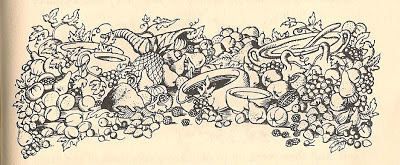
Picture credits:
Cooking pot: Wikimedia Commons
Fish 'n chips Wikimedia Commons, by Steven Lilley
Feast - by Pauline Baynes, illustration from 'Prince Caspian'
Published on December 07, 2012 02:15
November 30, 2012
The Lady of Llyn y Fan Fach
by Lily Hyde

It's more than a year now I’ve been on the road. I’ve spent most of my adult life in other countries than the one I was born in. I’ve been reading and writing fairy tales for as long as I can remember.
Sometimes I blame fairytales for my longing to travel and encounter unknown people and places. Many fairytales involve journeys: across mountains of glass, forests of thorns, the seven miles of steel thistles of this blog’s title. And of course the tales themselves travel; versions of ‘Cupid and Psyche’ appearing in Scandinavia, Japan…
Even more stories involve a meeting between the ordinary and the unknown; indeed, isn’t that where their name comes from – fairy or faerie, that other realm that is so like our own but so utterly different. Some of my most-loved fairytales, the ones that have worked their way into my life and writing, are about encountering the new and strange, and falling hopelessly in love with it.
I don’t know where I first read or heard ‘The Lady of Llyn y Fan Fach’. It seems I’ve always known the story. But I came across it again on a neglected bookshelf in Kiev, in a book of folk tales from the British Isles bizarrely published – transcribed regional accents and all – in the Soviet Union.
I seized on this book like a piece of home. I was sharing my life with a man from a different country, a stranger in his strange land. Sometimes I felt like I was living in a fairytale. I felt like the lady of Llyn y Fan Fach.
In this Welsh tale, a shepherd by the lake in the Black Mountains sees a beautiful woman appear on the water, and falls in love. He woos her with his lunch, bread his mother baked, and finally wins her on the third try with bread that is neither over- nor under-cooked. The lady – fairy or goddess or just a stranger from a strange land, we are never told – agrees to live with the man until he strike her ‘Tri ergyd diachos’ – three causeless blows.
What happens next is a paradigm of a marriage.
The first time, they are late for a christening and the lady says she will fetch the horse to ride there if her husband brings her gloves. But when he comes back with the gloves she hasn’t brought the horse, and he strikes her.
The second time, the shepherd strikes her at a wedding after she starts weeping loudly “because these people are entering into trouble”.
The third time she begins to laugh uncontrollably at a funeral, because, she says, death puts people out of their pain. And he strikes her.
‘She then went out of the house saying, “The last blow has been struck, our marriage contract is broken and at an end. Farewell!”’
For me this story is about the encounter with the unknown, its fascination and its incommensurability. Maybe the lady knows the marriage will end in unhappiness – usually in fairytales when someone is told not to do something or else, you know they’re going to do it. But she marries the shepherd anyway. Maybe she is as charmed by his difference as he is enchanted by hers; the story doesn’t tell.
Yet the lady’s differences from her husband are not really between fairy and mortal. They’re the yawning gaps in understanding between two people.
The first time is a classic scene of family frayed tempers. The annoyed husband strikes her gently enough (it’s always emphasised that his blows are gentle) because she broke a promise and lied to him, however frivolously; suddenly she is not what she seems.
The second time, he must be baffled and embarrassed by her strange behaviour at the wedding – and maybe wondering what she is trying to say about their marriage.
The third time, at a funeral, he is surely shocked by the apparent heartlessness and bad manners of this person he can’t understand.
How can you ever causelessly strike the one you love? But the moment comes, the gap opening at your feet as you realise this person you love and think you know is a stranger; a liar, a laugher at funerals and a weeper at weddings, someone you simply do not know. You teeter on the brink of the pit; that’s when you lash out.
There is a lovely, wise, updated Joan Aiken version of the Welsh story, called ‘The People in the Castle’. The anti-social village doctor falls in love with the lady’s silence and mystery, and is disappointed when after moving in with him she turns out to be a sociable, movie-loving chatterbox. It’s as if he’s married a swan, only to find out she is just a girl in a feather dress.
That brings me to those stories in which people marry beings who are literally not what they seem: the white bear who is actually a prince; the frog who is Vassilisa the wise and clever under a spell – stories that retell ‘Cupid and Psyche’.
Very often it’s glimpsing this truth sooner than they should, through curiosity, impatience or embarrassment (everyone thinks I’m married to a frog/a bear/something I can’t even see – the humiliation!), that parts couples and sends the heroines or heroes off on their travels across glass mountains and forest of thorns to bring their beloved, in his or her true form, back home.
Those are the optimistic stories.
The pessimistic version is that harsh lesson in not knowing and curiosity, ‘Bluebeard’s Castle’, in which the wife discovers her husband is hiding the dead bodies of his previous wives. A more mixed (and gender-reversed) Russian version tells of Queen Marya Morieva and her husband Ivan, who however much he loves her can’t resist opening the forbidden cellar door. Out comes Koschei Deathless to chop Ivan into pieces (“Let him chop!” says Ivan recklessly, “for if I can’t live with you, Marya Morieva, I would rather not live at all.”)
“If you had only waited and not peeked,” reproach these secretive lovers who are not what they seem. “If you had only listened to me and not opened the door.” A trust has been broken, and hardship and separation ensues.
In many stories, the love, courage and ingenuity of the heroes or heroines ensures reunion, and a traditional Happy Ever After. Through these journeys to find their lovers (or more rarely siblings or parents), people discover themselves; no longer passive partners being married off or carried off, but actively seeking happiness.
Other stories suggest that the whole of another person is, in the end, impossible to grasp. And if we can’t accept the ultimate unknowability of the one we love, then we are destined to live forever apart. Like the Gaelic seal bride, who always finds her seal skin however the husband hides it, and goes back to her unknowable life in the sea. Like the Japanese Sea King’s daughter in the tale ‘The Sea King and The Tide Jewels’, who leaves forever when her husband discovers her true, truly other form is that of a dragon.
Joan Aiken takes pity on her Welsh doctor, and has the mysterious lady return to him one night. The Lady of Llyn y Fan Fach never comes back. She does show herself to her sons though and teaches them medicine, thus rooting the tale in historical reality since these sons established a line of famous Welsh physicians that continued till the 18th century.
I won’t tell you the end of my own story with a beloved from a different land. But it’s only in writing this reflection that I’ve realised one of my novels, a sequel to Riding Icarus, tells just this kind of fairytale journey.
The heroine, Masha, runs away from her mother, who is traumatised from an unwilling journey into the realities of trafficking, and sets off on her own journey across Siberia to Kamchatka and her absent father. There Masha meets a rat who is really a boy; she discovers her father is not what he seems – or what she wants him to be. In the end she realises the purpose of her journey wasn’t what she thought at all; really it is the true form of her mother she was trying to find and to rescue all the time. Her mother as a complicated, vulnerable person in her own right; someone Masha has to get to know just as in turn her mother has to get to know her, while both accepting there are things they will never truly understand about each other.
My editors thought the ending of this book wasn’t Happy Ever After enough for its intended young adult audience.
But where is the real fairytale, the happy magic, in a story like ‘The Lady of Llyn y Fan Fach?’
Maybe in this: we can never truly know, but despite and because and anyway, how much we can love…

LILY HYDE has travelled through Russia, the Ukraine and the Crimea, China and Tibet:, and we first met online when she sent me an irresistable email:
I have to tell you this – I’m in Tagong, which is a tiny town high in the grasslands on the edge of the Tibetan plateau, full of monasteries and prayer flags and yaks and swaggering cowboys holding hands, wearing Stetsons, and with silver and coral rings in their black plaits… and in the hostel where I’m staying I found a copy of ‘Troll Fell’!I thought you’d like to know how far your words have travelled (further away from the sea than the Vikings ever got?)
Lily’s first book, ‘Riding Icarus’, is the enchanting story of Masha, who lives with her grandmother in an abandoned trolley-bus (called Icarus), ‘on the very edge of Kiev, by the Dnieper River. With no overhead electric wires to fix onto, the two long springy rods attached to the roof waved in the air like antennae, forever searching for a new source of power on which to drive away.’
Masha’s father went away to Kamchatka four years ago, and then Igor, her mother’s ‘friend’, appears:
Igor, who told Masha to call him uncle even though he wasn’t, and who had found Mama a job abroad where she could earn lots of money. So Mama had gone to Turkey, leaving Masha with Granny.
The story, while rooted firmly in modern Kiev, develops into a tale of magical midsummer wishes and your heart’s desire, dancing Cossacks, mystical tigers, the power of love and friendship, and an exceedingly nasty and all-too-believable villain. Lily writes with a sure but delicate touch, and the serious theme of people-trafficking is clearly hinted at without ever becoming too heavy for younger readers. Lily's second novel for children is 'Dream Land'.
Lily blogs at This Trolleybus is Going East.
Picture credits:
Llyn y Fan Fach by SNappa2006, Wikimedia Commons
Lyyn y fan Fach in winter by Dara Jasumani, Wikimedia Commons

It's more than a year now I’ve been on the road. I’ve spent most of my adult life in other countries than the one I was born in. I’ve been reading and writing fairy tales for as long as I can remember.
Sometimes I blame fairytales for my longing to travel and encounter unknown people and places. Many fairytales involve journeys: across mountains of glass, forests of thorns, the seven miles of steel thistles of this blog’s title. And of course the tales themselves travel; versions of ‘Cupid and Psyche’ appearing in Scandinavia, Japan…
Even more stories involve a meeting between the ordinary and the unknown; indeed, isn’t that where their name comes from – fairy or faerie, that other realm that is so like our own but so utterly different. Some of my most-loved fairytales, the ones that have worked their way into my life and writing, are about encountering the new and strange, and falling hopelessly in love with it.
I don’t know where I first read or heard ‘The Lady of Llyn y Fan Fach’. It seems I’ve always known the story. But I came across it again on a neglected bookshelf in Kiev, in a book of folk tales from the British Isles bizarrely published – transcribed regional accents and all – in the Soviet Union.
I seized on this book like a piece of home. I was sharing my life with a man from a different country, a stranger in his strange land. Sometimes I felt like I was living in a fairytale. I felt like the lady of Llyn y Fan Fach.
In this Welsh tale, a shepherd by the lake in the Black Mountains sees a beautiful woman appear on the water, and falls in love. He woos her with his lunch, bread his mother baked, and finally wins her on the third try with bread that is neither over- nor under-cooked. The lady – fairy or goddess or just a stranger from a strange land, we are never told – agrees to live with the man until he strike her ‘Tri ergyd diachos’ – three causeless blows.
What happens next is a paradigm of a marriage.
The first time, they are late for a christening and the lady says she will fetch the horse to ride there if her husband brings her gloves. But when he comes back with the gloves she hasn’t brought the horse, and he strikes her.
The second time, the shepherd strikes her at a wedding after she starts weeping loudly “because these people are entering into trouble”.
The third time she begins to laugh uncontrollably at a funeral, because, she says, death puts people out of their pain. And he strikes her.
‘She then went out of the house saying, “The last blow has been struck, our marriage contract is broken and at an end. Farewell!”’
For me this story is about the encounter with the unknown, its fascination and its incommensurability. Maybe the lady knows the marriage will end in unhappiness – usually in fairytales when someone is told not to do something or else, you know they’re going to do it. But she marries the shepherd anyway. Maybe she is as charmed by his difference as he is enchanted by hers; the story doesn’t tell.
Yet the lady’s differences from her husband are not really between fairy and mortal. They’re the yawning gaps in understanding between two people.
The first time is a classic scene of family frayed tempers. The annoyed husband strikes her gently enough (it’s always emphasised that his blows are gentle) because she broke a promise and lied to him, however frivolously; suddenly she is not what she seems.
The second time, he must be baffled and embarrassed by her strange behaviour at the wedding – and maybe wondering what she is trying to say about their marriage.
The third time, at a funeral, he is surely shocked by the apparent heartlessness and bad manners of this person he can’t understand.
How can you ever causelessly strike the one you love? But the moment comes, the gap opening at your feet as you realise this person you love and think you know is a stranger; a liar, a laugher at funerals and a weeper at weddings, someone you simply do not know. You teeter on the brink of the pit; that’s when you lash out.
There is a lovely, wise, updated Joan Aiken version of the Welsh story, called ‘The People in the Castle’. The anti-social village doctor falls in love with the lady’s silence and mystery, and is disappointed when after moving in with him she turns out to be a sociable, movie-loving chatterbox. It’s as if he’s married a swan, only to find out she is just a girl in a feather dress.
That brings me to those stories in which people marry beings who are literally not what they seem: the white bear who is actually a prince; the frog who is Vassilisa the wise and clever under a spell – stories that retell ‘Cupid and Psyche’.
Very often it’s glimpsing this truth sooner than they should, through curiosity, impatience or embarrassment (everyone thinks I’m married to a frog/a bear/something I can’t even see – the humiliation!), that parts couples and sends the heroines or heroes off on their travels across glass mountains and forest of thorns to bring their beloved, in his or her true form, back home.
Those are the optimistic stories.
The pessimistic version is that harsh lesson in not knowing and curiosity, ‘Bluebeard’s Castle’, in which the wife discovers her husband is hiding the dead bodies of his previous wives. A more mixed (and gender-reversed) Russian version tells of Queen Marya Morieva and her husband Ivan, who however much he loves her can’t resist opening the forbidden cellar door. Out comes Koschei Deathless to chop Ivan into pieces (“Let him chop!” says Ivan recklessly, “for if I can’t live with you, Marya Morieva, I would rather not live at all.”)
“If you had only waited and not peeked,” reproach these secretive lovers who are not what they seem. “If you had only listened to me and not opened the door.” A trust has been broken, and hardship and separation ensues.
In many stories, the love, courage and ingenuity of the heroes or heroines ensures reunion, and a traditional Happy Ever After. Through these journeys to find their lovers (or more rarely siblings or parents), people discover themselves; no longer passive partners being married off or carried off, but actively seeking happiness.
Other stories suggest that the whole of another person is, in the end, impossible to grasp. And if we can’t accept the ultimate unknowability of the one we love, then we are destined to live forever apart. Like the Gaelic seal bride, who always finds her seal skin however the husband hides it, and goes back to her unknowable life in the sea. Like the Japanese Sea King’s daughter in the tale ‘The Sea King and The Tide Jewels’, who leaves forever when her husband discovers her true, truly other form is that of a dragon.
Joan Aiken takes pity on her Welsh doctor, and has the mysterious lady return to him one night. The Lady of Llyn y Fan Fach never comes back. She does show herself to her sons though and teaches them medicine, thus rooting the tale in historical reality since these sons established a line of famous Welsh physicians that continued till the 18th century.
I won’t tell you the end of my own story with a beloved from a different land. But it’s only in writing this reflection that I’ve realised one of my novels, a sequel to Riding Icarus, tells just this kind of fairytale journey.
The heroine, Masha, runs away from her mother, who is traumatised from an unwilling journey into the realities of trafficking, and sets off on her own journey across Siberia to Kamchatka and her absent father. There Masha meets a rat who is really a boy; she discovers her father is not what he seems – or what she wants him to be. In the end she realises the purpose of her journey wasn’t what she thought at all; really it is the true form of her mother she was trying to find and to rescue all the time. Her mother as a complicated, vulnerable person in her own right; someone Masha has to get to know just as in turn her mother has to get to know her, while both accepting there are things they will never truly understand about each other.
My editors thought the ending of this book wasn’t Happy Ever After enough for its intended young adult audience.
But where is the real fairytale, the happy magic, in a story like ‘The Lady of Llyn y Fan Fach?’
Maybe in this: we can never truly know, but despite and because and anyway, how much we can love…

LILY HYDE has travelled through Russia, the Ukraine and the Crimea, China and Tibet:, and we first met online when she sent me an irresistable email:
I have to tell you this – I’m in Tagong, which is a tiny town high in the grasslands on the edge of the Tibetan plateau, full of monasteries and prayer flags and yaks and swaggering cowboys holding hands, wearing Stetsons, and with silver and coral rings in their black plaits… and in the hostel where I’m staying I found a copy of ‘Troll Fell’!I thought you’d like to know how far your words have travelled (further away from the sea than the Vikings ever got?)
Lily’s first book, ‘Riding Icarus’, is the enchanting story of Masha, who lives with her grandmother in an abandoned trolley-bus (called Icarus), ‘on the very edge of Kiev, by the Dnieper River. With no overhead electric wires to fix onto, the two long springy rods attached to the roof waved in the air like antennae, forever searching for a new source of power on which to drive away.’
Masha’s father went away to Kamchatka four years ago, and then Igor, her mother’s ‘friend’, appears:
Igor, who told Masha to call him uncle even though he wasn’t, and who had found Mama a job abroad where she could earn lots of money. So Mama had gone to Turkey, leaving Masha with Granny.
The story, while rooted firmly in modern Kiev, develops into a tale of magical midsummer wishes and your heart’s desire, dancing Cossacks, mystical tigers, the power of love and friendship, and an exceedingly nasty and all-too-believable villain. Lily writes with a sure but delicate touch, and the serious theme of people-trafficking is clearly hinted at without ever becoming too heavy for younger readers. Lily's second novel for children is 'Dream Land'.
Lily blogs at This Trolleybus is Going East.
Picture credits:
Llyn y Fan Fach by SNappa2006, Wikimedia Commons
Lyyn y fan Fach in winter by Dara Jasumani, Wikimedia Commons
Published on November 30, 2012 01:06
November 23, 2012
The Legend of the Pineapple
by Candy Gourlay
Are there such things as fairy tales in the Philippines where I grew up? If a fairy tale requires a fairy, then no - we don't have wand-wielding, tutu-wearing creatures in our woods (I would say rain forests, except most of those have been chopped down).
What's in a fairy tale? Magic, certainly. An evil power perhaps - wicked stepsisters, witches, magic foul versus heroine fair. A resolution that involves come-uppance? Happily ever afters?
I thought the best way to reflect on this subject was to do my own re-telling of a Filipino sort of fairy tale ... so here is my video re-telling of The Legend of the Pineapple, an old Filipino story.
I made the video with the help of my young neighbours, Christiane and Jacob (Jacob very kindly agreed to be the voice of a little girl as long as I used his drawing of a jet plane - watch out for it!):
The Legend of the Pineapple from Candy Gourlay on Vimeo.
I grew up listening to stories like these told by my parents usually during the frequent evening power cuts that plagued my childhood in Manila. We would light candles and katol (an incense-like mosquito repellent) and sit around the dining table telling stories until the power cuts were over.
The stories were always about everyday things - the turtle, that mountain we always drove past, that plant with leaves that folded when touched ... but unlike the happily ever afters of Western fairy tales, the endings always had a sadness to them.
A man turned arrogant and overbearing by his rapid success, turns into the shamefully slow turtle. (The Legend of the Turtle)
 Maria Makiling (Photo: Life Expressions blog)A young woman, abandoned by her lover, falls into an eternal sleep - and will forevermore be a mountain. (The Legend of Maria Makiling)
Maria Makiling (Photo: Life Expressions blog)A young woman, abandoned by her lover, falls into an eternal sleep - and will forevermore be a mountain. (The Legend of Maria Makiling) Makahiya plant (Sensitive Plant)A painfully shy child trying to overcome her shyness ventures out only to be crushed by cruel strangers. She turns into the makahiya, a grass-like creeper whose leaves shrink away and fold when touched. (The Legend of the Makahiya)
Makahiya plant (Sensitive Plant)A painfully shy child trying to overcome her shyness ventures out only to be crushed by cruel strangers. She turns into the makahiya, a grass-like creeper whose leaves shrink away and fold when touched. (The Legend of the Makahiya)Yes, there is magic but there is a helplessness in the face of greater, unstoppable powers in these stories. And inevitably it's not good magic, but bad.
The Philippines is a country always on alert for disaster - year after year, typhoons sweep in without fail, floods ruin crops, earthquakes, tsunamis, volcanoes ... living with constant catastrophe has invested the culture with a diffidence - bahala na ("Let it be" or "God wills it") is a common expression. Catholicism (we are the only Catholic country in Asia) exacerbates this fatalism.
The odd thing is when I was a child, I don't think I regarded these magical stories as fairy tales. With disaster so much a part of the fabric of life, they just seemed too real to be fairy stories.
I found my old school primer the other day from when I was seven years old.
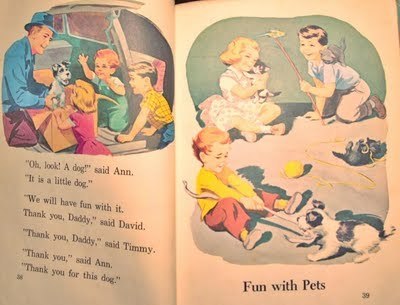 The Cathedral Reader series, with Ann, David, little Timmy and their fluffy pets who lived on clean roads with white picket fencesNow I didn't question the provenance of these stories or the other stories I read in books - the ones about Cinderellas, witches, evil stepmothers and the like. There wasn't a lot of publishing (and very few books for children) in the Philippines at the time. Most books were imported from America and Britain.
The Cathedral Reader series, with Ann, David, little Timmy and their fluffy pets who lived on clean roads with white picket fencesNow I didn't question the provenance of these stories or the other stories I read in books - the ones about Cinderellas, witches, evil stepmothers and the like. There wasn't a lot of publishing (and very few books for children) in the Philippines at the time. Most books were imported from America and Britain.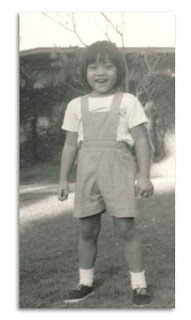 Six year old me.
Six year old me. The world of reading, for me, was about somewhere else. In those books, nowhere looked like home, and nobody looked like me - not even in one of my favourite picture books, The Five Chinese Brothers!
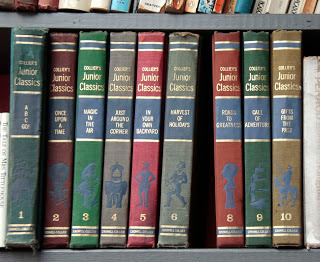 Most of my reading came from bound collections like these, courtesy of door-to-door salesmen selling encyclopedias and other bound collections that we paid for by installment. I've kept the old collection that I read as a child and dip into them to this day.
Most of my reading came from bound collections like these, courtesy of door-to-door salesmen selling encyclopedias and other bound collections that we paid for by installment. I've kept the old collection that I read as a child and dip into them to this day. It was all fantasy. Everything I read was a fairy tale.
It was only when I came to live here in Europe that I discovered there really were castles and hundred acre woods and foxes and kings and twisty-turny cobbled alleys and Black Forests. It takes a big leap for me to think that those fairy tales I read as a child were based on real places and possibly real people.
Huh. So those storytellers of long ago were writing about themselves.
And perhaps their readers were thinking: these stories are too close to the bone to be fairy tales.
CANDY GOURLAY was a young journalist writing for the opposition during the dictatorship of Ferdinand Marcos in the Philippines. After the revolution that toppled Marcos, she moved to London with her English husband and, as she says, 'attended to dictators of the nappy-clad variety before trying my hand at children's fiction.'
Her debut novel, 'Tall Story', published in 2010, is the story of two children. Andi lives in London, and she has two big wishes. One, she is desperate to play on the basketball team of her new school. She may be small, but she's good and she knows it. But guess what? They only take boys. Her other big wish is that her sixteen year old half-brother, Bernardo Hipolito, could come and live with them - if only the Foreign Office would grant him a visa. And finally, after years of waiting, this wish comes true. As Bernardo's plane arrives from the Philippines, Andi hopes he'll turn out to be tall and just as mad as she is about basketball. And Bernardo turns out to be tall, all right. But he's not just tall ... he's a GIANT.
Woven into the narrative are many of the folktales and fairytales of the Philippines. Bernardo is named after a Philippino folklore hero, the giant Bernardo Carpio, big enough to plough fields with his comb and carve mountains with his fingers. Superstition and fear rule the village in the person of Mad Nena, the village witch and her daughter Gabriela. A case of rabies is treated with charms, and young Bernardo is allowed to grow taller and taller without ever being taken to a doctor...
Tall Story was shortlisted for eleven children’s book prizes including the Waterstone’s, the Branford Boase and the Blue Peter prize. It won the Crystal Kite Children’s Book Prize for Europe. Candy's second book, book, 'Shine', will be published in 2013.
Published on November 23, 2012 00:44
November 16, 2012
Wild Edric - and the art of writing
by Pauline Fisk
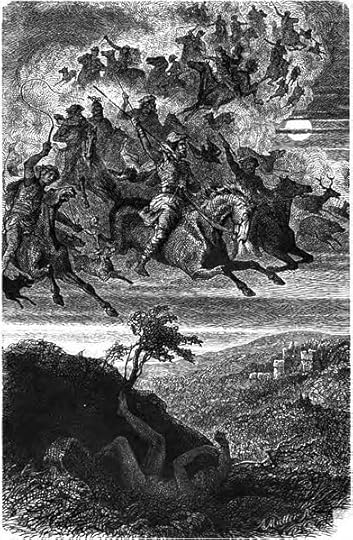
My whole life has been spent trying to bring together ‘real life’ and the world of fantasy, in particular by finding new and interesting ways of expressing a sense of the magical in my writing. Ever since I was five years old, hunting down fairies in the back alley behind my parents’ house, a sense of more to life than meets the eye has been part of who I am. When I was a child, life was one big fairy tale. That was how I felt. But how to get into that fairy tale? How to make that fairy tale my life, and make it real and be a part of it?
It was through stories that I found the way. I couldn’t write when I was five years old, but I could make up stories and that was what I did, standing at the garden fence, telling them out loud to the big children in the house next door, lined up on their side of the fence asking, ‘What happened next?’ But those stories, made up off the top of my head, were ephemeral. They were fly-by-nights, whereas words on paper had a strange new durability which I discovered when I learnt to write. Describing Winnie the Pooh hunting honey made me part of the story. Adventuring with the Famous Five turned them into a Famous Six. I made those things my own, and I made them real - and simply by writing about them.
This is something I’ve been doing ever since. When, at the end of ‘Mad Dog Moonlight’, I wrote about a river flowing through the stars, I put myself onto that river and sailed away. When Abren in ‘Sabrina Fludde’ turned to water and flowed down a mountain, I flowed too. And when hoof-prints beat upon the hill behind my house, I knew that Wild Edric, himself - that glorious superhero of Shropshire legend - was passing in the night. By writing him into ‘Midnight Blue’, I wasn’t just making him up. The act of writing brought him to life.
Tolkien defines fairy tales as stories about the adventures of humankind in Faerie, and here amongst the hills, valleys, woods and towns of my home county, Shropshire, Faerie’s all around me. It’s where I live. It’s a fabled place. And I’m twice blessed, because it also exists inside my head.
The power of imagination is the land called Faerie. ‘We may put a deadly green upon a man’s face and produce horror. We may make the rare and terrible blue moon to shine, or we may cause woods to spring with silver leaves and rams to wear fleeces of gold. In such ‘fantasy’ as it is called, new form is made; Faerie begins, Man becomes a sub-creator.’
Tolkien again, who wrote fairy tales for adults to read as a natural branch of literature rather than playing at ‘being children’, or pretending to enjoy them for the sake of the kids. ‘When we can take green from grass, blue from leaves and red from blood, we have already an enchanter’s power,’ he wrote. And what else compares to having that power?
As a child I was captivated by Hans Christian Anderson’s Fairy Tales. As a teenager I discovered Alan Garner’s ‘Weirdstone of Brisingamen’. Starting out in life as a writer myself, I fell head-first into Tolkien, and took some extracting. Finally I found my own voice and my own way into Faerie. This was a long process, which is what the word ‘finally’ is all about. For many years I thought that if I sounded like the writers I admired, Emily Bronte, Dylan Thomas, JRR Tolkien, Graham Greene – whoever the favourite of the moment might be – then I’d be a ‘proper’ writer but, if I sounded like myself, nobody would ever read me. A book of terrible short stories was published at the age of twenty-three [long since out of print, thank God], its lofty style definitely not mine. It wasn’t until years later, embarking upon ‘Midnight Blue’ that I developed the confidence as a writer to be myself.
I’m indebted to that decision. ‘Midnight Blue’ would never have been written without it. But it also would never have been written without Charlotte Burne, the first woman president of the Folklore Society, whose ‘Shropshire Folk-Lore: A Sheaf of Gleanings’ introduced me to Wild Edric, whose mysterious presence haunts ‘Midnight Blue’.
According to legend, whenever England is in danger, Wild Edric and his knights rise up from their sleep of centuries beneath a rugged range of Shropshire hills called the Stiperstones, and ride out in warning of impending doom. Charlotte Burne recorded conversations with people who claimed he’d been heard and seen before both the Battle of Waterloo and the First World War.
The history behind the story, as recorded in the Anglo-Saxon Chronicles, tells of a local lord who, having refused to submit to the Norman Conquest by raising a rebellion which was decisively defeated, betrayed his people by joining forces with the Conqueror. For this dastardly about-face, ‘Wild Edric’, as he became known, was doomed to sleep beneath the Stiperstones with his knights, only ever finding the release of death when England returned to her rightful people. He sleeps still, and some legends have added the comfort of a fairy wife, the Lady Godda, though others have him meeting and losing her before his days of betrayal and doom.
Wild Edric’s is a great story and, both as legend and history, he’s alive and well in Shropshire. After writing him into ‘Midnight Blue’, I attended a history society meeting where local Stiperstones people claimed to have heard him riding by, and one person even claimed direct descent. And he’s alive and well in my life too. I've talked about him at a weekend I’m running on myths and legends and how to use them in creative writing. I've even led a walk up to the Devil’s Chair, where he and his knights are supposed to burst out of the ground.
It’s years now since I wrote ‘Midnight Blue’, but Wild Edric has stayed with me ever since. My books have included other characters I first came across in Charlotte Burne. including the highwayman Humphrey Kynaston, and the goddess of the River Severn, brought to life in ‘Sabrina Fludde’. But nowhere have I found a sadder doom than Edric’s, lying beneath cold rocks, unable to die - unable even to be at peace.
The romance of Edric is Arthurian. He too is meant to sleep until his country is set free. And the legend of Alderley, which Alan Garners drew on in his book, ‘The Weirdstone of Brisingamen’, calls forth sleeping knights as well. They’re a universal emblem – and yet they’re a personal emblem too, especially if you’re a writer.
Every writer’s like a sleeping knight beneath a hill, brought to life when he or she has a story to tell, rising in the dark to gallop forth with a laugh, or tears or a chill breeze to broadcast to the waiting world. When I’m writing, I feel alive. When I’m not, I feel asleep. It’s as powerful as that. Maybe the idea of writers as the white-knight guardians of a watching world sounds a bit fanciful to you. But I’d say not. I’d say what we do matters more than anyone could ever say, and that the idea of an Edric who performs the role of guardian is only there because people want it, just as they want writing, and stories and people like me.
So I can’t help but identify with Wild Edric. He and I are two sides of the same coin. He’s an age-old legend, trying to break free, and I’m a fresh-faced pilgrim at the gate of Faerie, trying to get in.
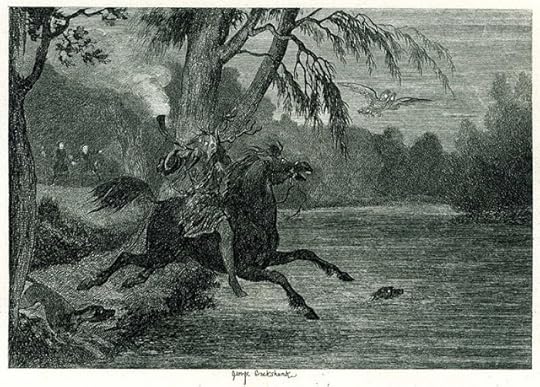
PAULINE FISK'S first book, ‘Midnight Blue’ won the Smarties Book Prize in 1990. It's the story of a girl called Bonnie who has just found a home with her very young mother, in an inner city block of flats. Just as it looks as if they can be happy together and build their relationship, her controlling and malevolent grandmother moves in: and Bonnie runs away, finding refuge in a mid-city oasis, a walled garden where a mysterious man called Michael is building a hot air balloon with the help of a strange shadowy boy. Michael’s aim is to fly to the land beyond the sky:
Beyond the sky. Not ‘in outer space’ or ‘in another galaxy’, but beyond the sky… as though it were possible to peel away the edge of the blue and pass straight through.‘Sabrina Fludde’(2001), opens with a body floating down the River Severn, the body of a lost, almost drowned girl whose memory is lost too, who plucks the strange name Abren out of the air for herself... In fact, the book is full of lost characters with strange names. In the end, Abren has to return to her own source (and that of the river) on the mountain Plynlimon, where a cold and sinister family claim her as their own. Alone and in terrible danger, she makes her escape down to the sea. And 'Mad Dog Moonlight' (2009) is another tale of a child seeking his true self and a place to belong. Pauline's latest book is 'Into the Trees', in which a boy comes to Belize looking for his father and falls in with a group of gap year volunteers. Living in the trees will change them all.
Pauline's books are beautifully written, interweaving strands of the real world with airy fibres so fine, they are barely even fantasy – more like mysticism, or elemental forces. She writes about vast emotional themes of love, anger, insecurity, and the need to belong to people and a place. They leave a lasting imprint on the mind.
Picture creditsThe Wild Hunt Illustration by Friedrich Wilhelm Heine,Wikimedia CommonsHerne the Hunter Illustration by George Cruikshank, scan by Steven J Plunkett, Wikimedia Commons
Published on November 16, 2012 02:03
November 14, 2012
Folklore Snippets: The Fisherman and the Merman
The Fisher and the Merman
From Scandinavian Folklore, ed William Craigie, 1896

Here’s a nice story about inter-species co-operation and the gratitude that follows a good deed. One good turn deserves another…
One cold winter day a fisherman had gone out to sea. It began to grow stormy when he was about to return and he had trouble enough to clear himself. He then saw, near his boat, and old man with a long gray beard, riding on a wave. The fisherman knew well that it was the merman he saw before him, and he knew also what it meant. “Uh, then, how cold it is!” said the merman as he sat and shivered, for he had lost one of his hose. The fisherman pulled off one of his, and threw it out to him. The merman disappeared with it, and the fisherman came safe to land. Some time after this, the fisherman was again out at sea, far from land. All at once the merman stuck his head over the gunwale, and shouted out to the man in the boat,
“Hear, you man that gave the hose, Take your boat and make for shore, It thunders under Norway.”
The fisherman made all the haste he could to get to land, and there came a storm the like of which has never been known, in which many were drowned at sea.
Picture credit:
''Sævarmaður'' (merman) by Anker Eli Petersen: 1998, 55x60cm, Føroya Læraraskúli (Teacher's highschool of the Faroe Island) Wikimedia Commons
Published on November 14, 2012 01:55
November 11, 2012
"Have a soul, All Souls!"

This Saturday, the 10th of November, there was a protest outside the prestigious gold-leaf-covered gate of All Souls College, Oxford. As an Oxford-based author, I went along to show some solidarity, although the protesters had been there for hours by the time I managed to arrive (delayed by guests and then by an accident that held up traffic on the Botley Road).
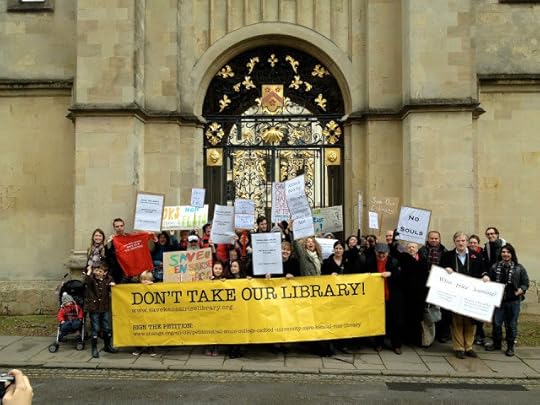
The people who stood there on the pavement from eleven o'clock till three were the concerned friends of Kensal Rise Library, in Brent, young and old, mums and dad and kids in pushchairs, who had come on a coach all the way up to Oxford, to ask All Souls College - one of the wealthiest colleges of the University of Oxford - not to sell Kensal Rise Library to a developer, Platinum Revolver Ltd, who wants to turn it into flats.
In case you don't already know the story, Kensal Rise Library was built by public subscription, and was opened in 1900 by Mark Twain on land belonging to All Souls. You can find out more about it here, and read a description by Maggie Gee of what it used to be like, here. Unfortunately that was before Brent Council summarily removed all the books and shut it down in October last year
The question now is whether All Souls, to whom building and land has now reverted, will act responsibly, and in the spirit of the original foundation - and restore the building to the community?
You can help by signing the petition , and joining the facebook group Save Kensal Rise Library.
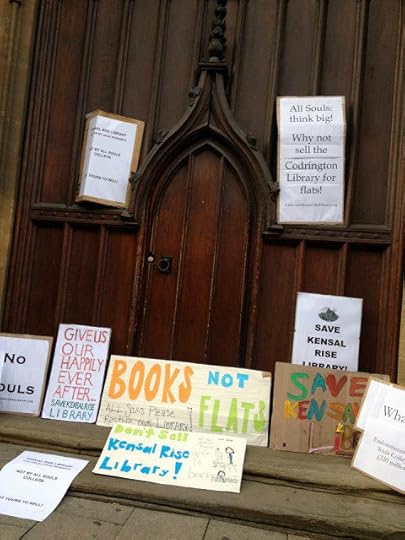
You'll see in the top right hand corner of this picture, a reference to All Souls' famous "Codrington Library". It would be easy to argue that All Souls ought to be just as proud or even prouder of Kensal Rise, which might not be as old as the Codrington Library, but at least wasn't founded by a man who made his fortune from the Jamaica plantations. (Christopher Codrington (1668–1710). But why should either library be endangered?
The latest news - after a highly successful and visible day out - comes from library campaigner Jodi Gramigni. She says, "All Souls were invited to join us, and although they weren't available on the day, a meeting to discuss their plans for Kensal Rise library is scheduled in a week's time."
Let's hope the news will be good news.
HAVE A SOUL, ALL SOULS!
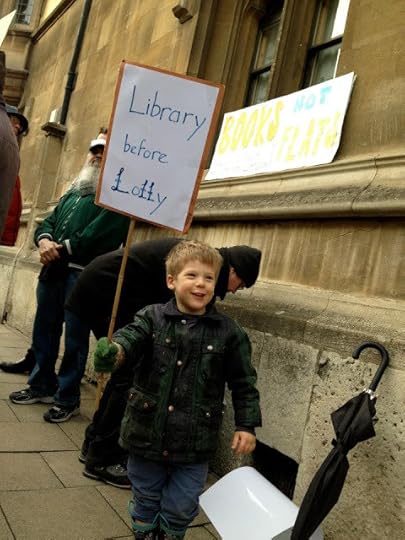
All photos copyright Simone Gramigni
Published on November 11, 2012 08:46
November 9, 2012
Talking of trolls
I'm taking the weekend off from Steel Thistles, as today you will find me talking about trolls to my friend Lucy Coats, over at Scribble City Central, her wonderful blog devoted to all things mythic. She's currently compiling a fascinating alphabet of mythical creatures, with help from many great fantasy writers: and we've reached the T's. Click on Scribble City, and I'll see you there!
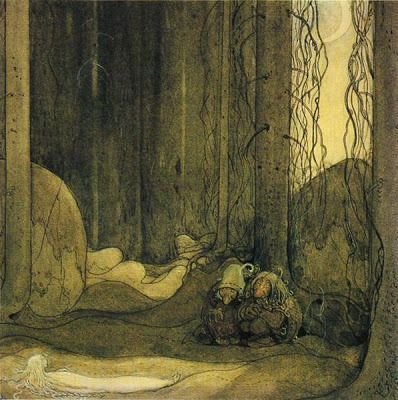
Picture credit: The Changeling, by John Bauer, 1913

Picture credit: The Changeling, by John Bauer, 1913
Published on November 09, 2012 00:13
November 2, 2012
Inglorious Miltons
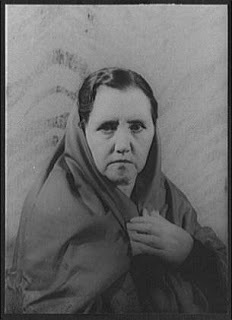 Sara Allgood as Maurya, photo by Carl Van Vechten, 1938Maurya: (raising her head and speaking as if she did not see the people around her) They're all gone now, and there isn't anything more the sea can do to me.... I'll have no call now to be up crying and praying when the wind breaks from the south, and you can hear the surf is in the east, and the surf is in the west, making a great stir with the two noises, and they hitting one on the other. I'll have no call now to be going down and getting Holy Water in the dark nights after Samhain, and I won't care what way the sea is when the other women will be keening. '(To Nora)' Give me the Holy Water, Nora; there's a small sup still on the dresser.
Sara Allgood as Maurya, photo by Carl Van Vechten, 1938Maurya: (raising her head and speaking as if she did not see the people around her) They're all gone now, and there isn't anything more the sea can do to me.... I'll have no call now to be up crying and praying when the wind breaks from the south, and you can hear the surf is in the east, and the surf is in the west, making a great stir with the two noises, and they hitting one on the other. I'll have no call now to be going down and getting Holy Water in the dark nights after Samhain, and I won't care what way the sea is when the other women will be keening. '(To Nora)' Give me the Holy Water, Nora; there's a small sup still on the dresser.Riders to the Sea by J M Synge, 1904
Unless they’re Irish peasants of the early 20thcentury, in which case we’ve been conditioned by John Synge and WB Yeats to expect them to speak in floods of natural wild Celtic poetry – we tend not to think of ordinary people – the-man-in-the-street – as likely to use particularly eloquent or colourful speech. And yet, why not? Robert Burns was untaught, and so was John Clare, and many a mute inglorious Milton may, as Gray suggests, have gone to his quiet grave without being known by more than the handful of folk amongst whom he or she lived. (In passing, there are so many Miltons among the villages near us here in Oxfordshire: Great Milton, Little Milton, Milton Park, etc., that one day I swear I'm going to create a couple of twinned villages called Mute Milton and Inglorious Milton, rather as Joan Aiken wrote about a village called Loose Chippings.)
But from such ordinary/extraordinary folk sprang the great poet Anon., without whom we would have no Border ballads, no Thomas the Rhymer or Tam Lin… no fairytales, no myths, no legends, no Bible, all of which were made up and told aloud by Mr and Mrs Anon long before they were written down and published in big, thick books. It's unimaginable. We’d have no proverbs, no skipping rhymes, no riddles, no jokes. People are just naturals at using colourful speech: you really and truly do not have to learn to read or write in order to appreciate beauty and express yourself.
I was reminded of all this by a section in a rather lovely book called ‘Folklore on The American Land’ by Duncan Emrich, pub. Little, Brown & Company, 1972. Here are some extracts.
An exuberant skipping rhyme from a school in Washington:
Salome was a dancerShe danced before the kingAnd every time she dancedShe wiggled everything.‘Stop,’ said the king,‘You can’t do that in here.’‘Baloney,’ said Salome,And kicked the chandelier.
And another:
 Grandma Moses sick in bedCalled the doctor and the doctor said‘Grandma Moses, you ain’t sick,All you need is a licorice stick.’
Grandma Moses sick in bedCalled the doctor and the doctor said‘Grandma Moses, you ain’t sick,All you need is a licorice stick.’I gotta pain in my side, Oh Ah!I gotta pain in my stomach, Oh Ah!I gotta pain in my head,Coz the baby said,Roll-a-roll-a-peep! Roll-a-roll-a-peep!Bump-te-wa-wa, bump-te-wa-wa,Roll-a-roll-a-peep!
Downtown baby on a roller coasterSweet, sweet baby on a roller coasterShimmy shimmy coco popShimmy shimmy POP!Shimmy shimmy coco popShimmy shimmy POP!
Children make these things up! Children! And from the Ozarks (from the French ‘Aux Arks’ – Arks: shortened form for Arkansas), Emrich provides any number of proverbial phrases and ways of speech.
Of a man who had been stung by yellowjackets: “He was actin’ like a windmill gone to the bad.” (That's comedy!)
In Boone County, Arkansas, a barefoot young farmer to his sweetheart: “The days when I don’t git to see you are plumb squandered away and lost, like beads off’n a string.” (That's a love poem...)
A fat little man with a square head and no neck worth mentioning: “He looks like a young jug with a cork in it.” (Worthy of Dickens!)
In Baxter County, Arkansas, a fellow professed dislike for the Robinson family: “Hell is so full of Robinsons that you can see their feet stickin’ out of the winders.” (Wonderful comic hyperbole and makes his point.)
And perhaps my favourite: on a very hot day an old woman says: “Ain’t it awful? I feel like hell ain’t a mile away and the fences all down.”
All of us are poets...
Picture credits
Jump rope: Wikimedia Commons Author Iksnigo
Published on November 02, 2012 02:12
October 30, 2012
Stolen by the Fairies

From ‘The Western Island’ by Robin Flower, Clarendon Press, 1944A tale of Tomàs O Crithin from the Great Blasket
It is not so long ago (said he), that a woman of my mother’s kin, the O’Sheas, was taken, and when I was young I knew people who had seen her. She was a beautiful girl, and she hadn’t been married a year when she fell sick, and she said that she was going to die, and that if she must die she would rather be in the home in which she had spent her life than in a strange house where she had been less than a year. So she went back to her mother’s house, and very soon she died and was buried. She hadn’t been buried more than a year when her husband married again, and he had two children by his second wife. But one day there came a letter with a seal on it.
It was from a farmer that lived in the neighborhood of Fermoy. He said that now for some months, when the family would go to bed at night in his farm, if any food were left out they would find it gone in the morning. And at last he said to himself that he would find out what it was that came at night and took the food. So he sat up in the corner of the kitchen one night, and in the middle of the night the door opened and a woman came in, the most beautiful woman he had ever seen with his eyes, and she came up the kitchen and lifted the bowl of milk they had left out, and drank of it. He came between her and the door, and she turned to him and said that this was what she had wanted. So he asked her who she was, and she said that she came from the liss at the corner of his farm, where the fairies kept her prisoner. They had carried her off from a place in Ventry parish, and left a changeling in her place, and the changeling had died and been buried in her stead.
She said that the farmer must write to her people and say that she was in the liss with the fairies, and that she had eaten none of the food of the fairies, for if once she ate of their food she must remain with them for ever till she died… and when he wrote to her people he must ask her mother if she remembered one night when her daughter lay sick, and the mother was sitting by the fire, and thinking so, she had forgotten everything else, and the edge of her skirt had caught fire. …If she remembered that night, it would be a token for her, for on that night her daughter had been carried off, and the fire in her mother’s skirt was the last thing she remembered of her life on earth. And when she said this she went out through the door, and the farmer saw her no more.
So the next day he wrote the letter as she had told him. But her people did nothing, for they feared that if they brought her back, there would be trouble because of the new wife and her two children. And she came again and again to the farmer, and he wrote seven letters with seals, and the neighbours all said it was a shame to them to leave her with the fairies in the liss; and the husband said it was a great wrong to leave his wife in the liss, and whatever trouble it would bring, they should go and fetch her out of the liss. So they set out, her own people and her husband, and when they had gone as far as Dingle, they said they would go and ask the advice of the priest.
So they went to the priest that was there at that time, and they told him the story from beginning to end. And when he heard the story, he said that it was a hard case, and against the law of the church. And the husband said that, when they had brought the woman out of the liss, he would not bring her back with him to make scandal in the countryside, but would send her to America, and would live with his second wife and her children. But the priest said that even if man’s wife were in America, she was still his wife, and it was against the law of the Pope that a man should have two wives; and, though it was a hard thing, they must leave her in the liss with the fairies, for it was a less evil that she should eat the fairy bread and be always with the fairies than that God’s law should be broken and a man have two wives living in this world.
They found nothing to say against the priest, and they went back home sorrowing. And when the woman heard this from the farmer she went back to the fairies to the liss, and ate their bread and remained with them.
Picture credit:
Take the Fair Face of Woman, and Gently Suspending, With Butterflies, Flowers, and Jewels Attending, Thus Your Fairy is Made of Most Beautiful Things - by Sophie Gengembre Anderson (1823-1903)
Published on October 30, 2012 02:47



